The veterinary allergy diagnostics market enters a decade of robust expansion that will transform dermatological diagnostics and allergen identification capabilities across companion animal care, specialty veterinary practice, and animal health applications. The market's progression from USD 370.0 million in 2025 to USD 714.4 million by 2035 represents accelerated growth, reflecting the increased adoption of advanced immunoassay technology and comprehensive allergy testing systems across canine diagnostics, feline health monitoring, and specialty dermatology applications worldwide.
The first half of the decade (2025-2030) will witness the market climbing from USD 370.0 million to approximately USD 514.1 million, adding USD 144.1 million in value, which constitutes 42% of the total forecast growth period. This phase will be characterized by the continued adoption of CLIA testing platforms and expanded testing panels, driven by increasing pet ownership and the growing need for precise allergen identification in companion animal dermatology, food allergy diagnosis, and environmental sensitivity assessment globally. Enhanced testing automation and comprehensive allergen databases will become standard expectations rather than premium options.
The latter half (2030-2035) will witness continued growth from USD 514.1 million to USD 714.4 million, representing an addition of USD 200.2 million or 58% of the decade's expansion. This period will be defined by mass market penetration of multiplex testing platforms, integration with comprehensive veterinary health networks, and seamless compatibility with existing clinic infrastructure. The market trajectory signals fundamental shifts in how veterinary professionals approach allergy management and diagnostic operations, with participants positioned to benefit from growing demand across multiple testing segments and species applications.
Veterinary allergy diagnostics encompass sophisticated immunoassay management systems coordinating allergen-specific IgE detection, environmental sensitivity screening, and food allergy identification across diverse companion animal populations and clinical applications. CLIA testing systems provide automated chemiluminescent detection through standardized protocols enabling high-sensitivity allergen identification for comprehensive allergy panels. Testing capabilities typically support detection of environmental allergens, food proteins, and contact sensitizers while maintaining analytical precision requirements for effective treatment planning and dietary management.
Canine allergy testing drives primary market demand through requirements for atopic dermatitis diagnosis, food sensitivity identification, and environmental allergen screening in dogs presenting with dermatological symptoms and chronic allergic conditions. Feline testing operations utilize specialized immunoassay protocols for cat-specific allergen panels addressing feline atopic syndrome, food allergies, and respiratory sensitivities. Equine applications encompass comprehensive allergen screening for horses with allergic dermatitis, respiratory conditions, and performance-limiting sensitivities.
ELISA testing platforms provide established immunoassay capabilities through enzyme-linked detection systems supporting routine allergy screening and follow-up monitoring. Multiplex bead-based assays offer simultaneous detection of multiple allergens through suspension array technology enabling comprehensive testing efficiency and expanded diagnostic coverage.
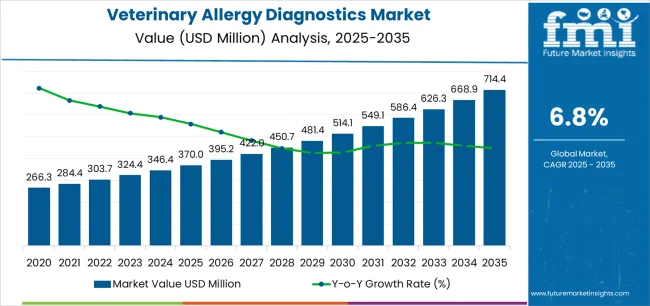
| Period | Primary Revenue Buckets | Share | Notes |
|---|---|---|---|
| Today | CLIA testing platforms | 47.5% | Advanced-driven, precision focus |
| ELISA testing systems | 34.3% | Established technology and routine testing | |
| Multiplex bead-based assays | 9.2% | High-throughput and comprehensive panels | |
| Canine testing applications | 72.3% | Primary species focus | |
| Veterinary clinics & hospitals | 58.3% | Primary service delivery | |
| Future (3-5 yrs ) | Enhanced CLIA platforms | 47.6% | Technology advancement, precision gains |
| Expanded ELISA solutions | 35.0% | Platform improvement, accessibility enhancement | |
| Advanced multiplex systems | 8.2% | Technology consolidation, efficiency optimization | |
| Comprehensive canine diagnostics | 72.5% | Testing expansion, coverage improvement | |
| Enhanced clinic services | 57.6% | Service optimization, accessibility enhancement | |
| Digital diagnostic platforms | 5-8% | IoT integration, data optimization |
| Metric | Value |
|---|---|
| Market Value (2025) | USD 370.0 million |
| Market Forecast (2035) | USD 714.4 million |
| Growth Rate | 6.8% CAGR |
| Leading Test Modality | CLIA Segment |
| Primary Species | Canine |
The market demonstrates strong fundamentals with CLIA testing capturing a dominant share through advanced diagnostic capabilities and testing optimization. Canine applications drive primary demand, supported by increasing companion animal care requirements and operational diagnostic development. Geographic expansion remains concentrated in developed markets with established veterinary infrastructure, while emerging economies show accelerating adoption rates driven by pet care modernization initiatives and rising veterinary accessibility standards.
Design for diagnostic versatility, not just test accuracy
Technology readiness for Veterinary 4.0
Precision-by-design approach
Value-based diagnostic models
Primary Classification: The market segments by test modality into CLIA (47.5%), ELISA (34.3%), multiplex bead-based (9.2%), microarray/solid-phase multiplex (3.4%), and others (5.6%), representing the evolution from basic screening methods to specialized immunoassay platforms for comprehensive allergy detection and clinical management.
Secondary Classification: Species segmentation divides the market into canine (72.3%), feline (12.1%), equine (6.5%), and others (9.1%), reflecting distinct requirements for species-specific testing, clinical management, and diagnostic protocol standards.
Tertiary Classification: End user segmentation covers veterinary clinics & hospitals (58.3%), emergency hospitals (4.5%), academic hospitals (2.3%), veterinary dermatology & specialty clinics (29.1%), and others (5.7%), demonstrating varied testing requirements and operational distribution standards.
The segmentation structure reveals diagnostic progression from standard screening methods toward specialized allergy testing applications with enhanced clinical consistency and diagnostic capabilities, while application diversity spans from routine screening to specialty dermatology requiring precise allergy management solutions.
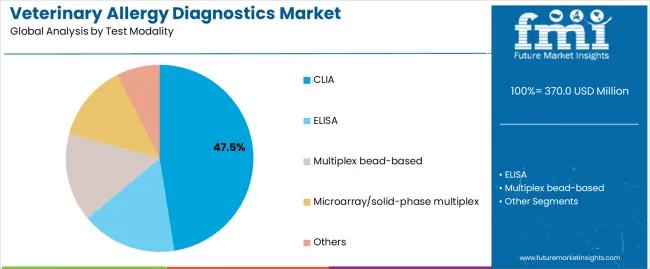
Market Position: CLIA testing commands the leading position in the veterinary allergy diagnostics market with 47.5% market share through advanced immunoassay features, including high sensitivity detection, operational efficiency, and testing optimization that enable laboratories to achieve optimal allergen identification across diverse companion animal populations and clinical applications.
Value Drivers: The segment benefits from laboratory preference for automated testing systems that provide consistent diagnostic performance, reduced processing complexity, and operational efficiency optimization without requiring significant equipment modifications. Advanced CLIA features enable automated sample handling, standardized protocols, and integration with existing laboratory systems, where diagnostic performance and clinical accuracy represent critical testing requirements.
Competitive Advantages: CLIA testing differentiates through proven diagnostic reliability, consistent immunoassay characteristics, and integration with automated laboratory management systems that enhance testing effectiveness while maintaining optimal accuracy standards for diverse clinical and specialty applications.
Key market characteristics:
ELISA Testing Systems Show Established Market Growth
ELISA testing maintains a 34.3% market position in the veterinary allergy diagnostics market due to their proven diagnostic properties and established clinical characteristics. These systems appeal to clinics requiring reliable performance with competitive positioning for routine allergy testing and follow-up monitoring applications. Market growth is driven by primary care segment expansion, emphasizing accessible diagnostic solutions and operational efficiency through optimized ELISA designs.
Multiplex Bead-Based Assays Show Advanced Testing Growth
Multiplex bead-based testing captures 9.2% market share through specialized diagnostic requirements in comprehensive screening operations, high-throughput testing, and advanced clinical applications. These operations demand certified testing systems capable of operating with multiple allergen detection while providing effective analytical management and testing performance capabilities.
Microarray/Solid-Phase Multiplex Systems Show Research Applications
Microarray testing accounts for 3.4% market share, including research applications, specialized protocols, and advanced testing requirements for diagnostic optimization and research accessibility.
Others Testing Methods Show Emerging Technologies
Other testing methods account for 5.6% market share, including emerging technologies, specialized techniques, and alternative testing requirements for diagnostic innovation and clinical advancement.
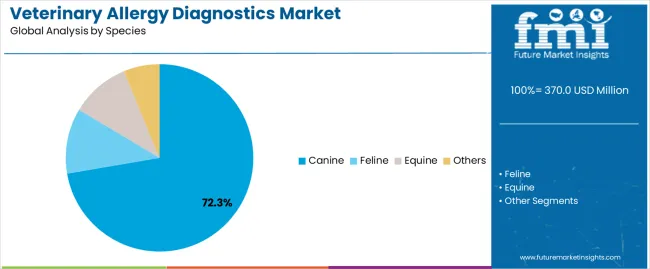
Market Context: Canine testing demonstrates market leadership in the veterinary allergy diagnostics market with 72.3% share due to widespread adoption of companion animal care systems and increasing focus on canine dermatology, allergy management, and testing applications that maximize pet health outcomes while maintaining clinical standards.
Appeal Factors: Veterinary professionals prioritize diagnostic reliability, clinical accuracy, and integration with existing canine care infrastructure that enables coordinated testing operations across multiple dermatological applications. The segment benefits from substantial pet care investment and health programs that emphasize the acquisition of canine testing systems for diagnostic optimization and treatment planning applications.
Growth Drivers: Companion animal care expansion programs incorporate allergy testing as standard diagnostic for canine operations, while pet health growth increases demand for consistent testing capabilities that comply with clinical standards and minimize diagnostic complexity.
Feline Testing Maintains Secondary Species Focus
Feline testing captures 12.1% market share through comprehensive diagnostic requirements in cat populations, specialty feline care, and allergy management applications requiring reliable testing systems capable of handling feline-specific sensitivities while providing effective diagnostic management and clinical performance capabilities.
Equine Testing Shows Specialized Growth
Equine testing accounts for 6.5% market share, including performance horses, recreational equines, and specialized veterinary requirements for diagnostic optimization and equine health management.
Others Species Show Diverse Applications
Other species testing accounts for 9.1% market share, including exotic animals, livestock applications, and specialized testing requirements for comprehensive veterinary care.
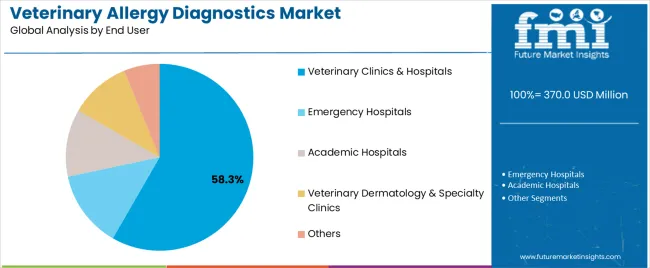
Market Context: Veterinary clinics & hospitals demonstrate market leadership in the veterinary allergy diagnostics market with 58.3% share due to widespread adoption of clinical testing systems and increasing focus on comprehensive care, diagnostic services, and testing applications that maximize patient outcomes while maintaining clinical standards.
Appeal Factors: Veterinary professionals prioritize diagnostic reliability, clinical efficiency, and integration with existing clinic infrastructure that enables coordinated testing operations across multiple clinical applications. The segment benefits from substantial clinic investment and modernization programs that emphasize the acquisition of testing systems for diagnostic optimization and patient care applications.
Growth Drivers: Veterinary clinic expansion programs incorporate allergy testing as standard diagnostic for clinical operations, while companion animal health growth increases demand for consistent testing capabilities that comply with clinical standards and minimize diagnostic complexity.
Application dynamics include:
Emergency Hospitals Maintain Acute Care Demand
Emergency hospitals capture 4.5% market share through comprehensive diagnostic requirements in urgent care settings, emergency procedures, and acute allergy presentations. These operations demand reliable testing systems capable of handling emergency diagnostics while providing effective clinical management and urgent care performance capabilities.
Academic Hospitals Show Educational Growth
Academic hospitals account for 2.3% market share, including teaching facilities, research institutions, and educational testing requirements for academic optimization and clinical training.
Veterinary Dermatology & Specialty Clinics Show Specialized Care
Specialty clinics account for 29.1% market share, including dermatology specialists, allergy clinics, and specialized care requirements for diagnostic optimization and specialty treatment.
Others End Users Show Diverse Applications
Other end users account for 5.7% market share, including research facilities, contract laboratories, and specialized testing requirements for diagnostic innovation and service accessibility.
| Category | Factor | Impact | Why It Matters |
|---|---|---|---|
| Driver | Pet ownership growth & companion animal care expansion (pet humanization, health awareness) | ★★★★★ | Large-scale pet care markets require efficient, reliable diagnostic solutions with consistent performance and clinical compliance across allergy applications. |
| Driver | Veterinary dermatology advancement & specialty care growth (dermatology practices, allergy specialists) | ★★★★★ | Drives demand for specialized diagnostic solutions and high-precision allergy testing capabilities; providers offering advanced testing systems gain competitive advantage. |
| Driver | Food allergy awareness & dietary management focus (pet nutrition, elimination diets) | ★★★★☆ | Pet care markets need comprehensive allergy solutions; demand for food allergy testing expanding addressable diagnostic segments. |
| Restraint | High testing costs & price sensitivity (diagnostic expense, pet owner budgets) | ★★★★☆ | Small clinics face cost pressure; increases price sensitivity and affects testing volume in budget-sensitive markets. |
| Restraint | Alternative treatment approaches & empirical therapy (steroid therapy, symptomatic treatment) | ★★★☆☆ | Cost-focused applications face challenges with diagnostic value and treatment justification, limiting adoption in price-sensitive segments. |
| Trend | Precision medicine advancement & personalized treatment (targeted therapy, individualized care) | ★★★★★ | Growing demand for precise diagnostic equipment; personalized integration becomes core value proposition in advanced veterinary segments. |
| Trend | Digital health integration & telemedicine expansion (remote diagnostics, digital platforms) | ★★★★☆ | Technology integration drives demand for connected diagnostic solutions; digital capabilities drive competition toward telehealth optimization. |
The veterinary allergy diagnostics market demonstrates varied regional dynamics with growth leaders including South Korea (5.1% growth rate) and India (4.7% growth rate) driving expansion through companion animal care initiatives and veterinary capacity development. Steady Performers encompass China (4.5% growth rate), USA (4.2% growth rate), and France (4.1% growth rate), benefiting from established veterinary industries and advanced diagnostic adoption. Mature Markets feature Brazil (3.8% growth rate), Japan (3.8% growth rate), and UK (3.6% growth rate), where veterinary technology advancement and clinical standardization requirements support consistent growth patterns.
Regional synthesis reveals Asian markets leading adoption through companion animal expansion and veterinary development, while Western countries maintain steady expansion supported by technology advancement and clinical standardization requirements. Emerging markets show strong growth driven by pet care applications and veterinary modernization trends.
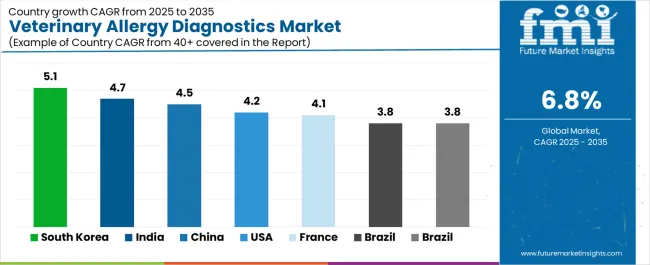
| Region/Country | 2025-2035 Growth | How to win | What to watch out |
|---|---|---|---|
| South Korea | 5.1% | Focus on advanced companion animal solutions | Technology costs; market saturation |
| India | 4.7% | Lead with cost-effective diagnostic systems | Infrastructure challenges; price sensitivity |
| China | 4.5% | Offer comprehensive pet care programs | Regulatory approval; market access |
| USA | 4.2% | Provide specialty clinic integration solutions | Market maturity; competition intensity |
| France | 4.1% | Premium diagnostic positioning | Regulatory compliance; cost pressures |
| Brazil | 3.8% | Premium pet care positioning | Economic volatility; infrastructure limitations |
| Japan | 3.8% | Premium technology positioning | Market saturation; cost sensitivity |
| UK | 3.6% | Comprehensive diagnostic services | Brexit impacts; regulatory changes |
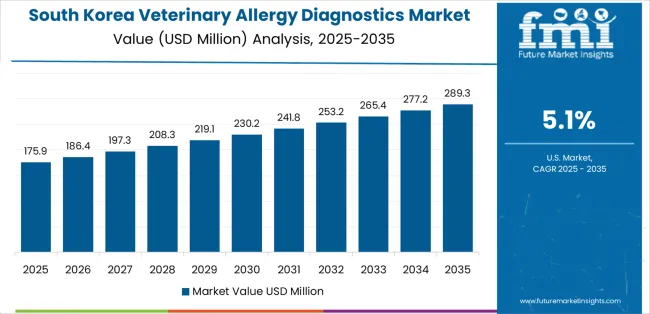
South Korea establishes fastest market growth through aggressive companion animal programs and comprehensive veterinary capacity development, integrating advanced veterinary allergy diagnostics as standard components in pet care systems and veterinary clinic installations. The country's 5.1% growth rate reflects government initiatives promoting companion animal welfare and veterinary development capabilities that support the use of diagnostic testing systems in veterinary facilities. Growth concentrates in major urban centers, including Seoul, Busan, and Incheon, where veterinary technology development showcases integrated testing systems that appeal to clinicians seeking advanced diagnostic optimization capabilities and operational companion animal applications.
Korean veterinary service providers are developing advanced diagnostic solutions that combine domestic pet care advantages with proven clinical features, including automated testing systems and enhanced reliability capabilities. Distribution channels through veterinary clinics and specialty care providers expand market access, while regulatory support for companion animal welfare supports adoption across diverse veterinary segments.
Strategic Market Indicators:
In Maharashtra, Karnataka, and Tamil Nadu regions, veterinary facilities and companion animal operations are implementing advanced allergy diagnostics as standard equipment for diagnostic optimization and operational veterinary enhancement, driven by increasing pet ownership growth and veterinary modernization programs that emphasize the importance of diagnostic capabilities. The market holds a 4.7% growth rate, supported by companion animal care initiatives and diagnostic infrastructure development programs that promote advanced testing systems for veterinary facilities.
Indian operators are adopting diagnostic systems that provide consistent clinical performance and cost-effective features, particularly appealing in urban regions where pet care expansion and affordability standards represent critical operational requirements. Market expansion benefits from growing companion animal populations and veterinary integration agreements that enable domestic development of diagnostic systems for pet care applications.
China establishes comprehensive pet care development through established companion animal programs and advanced veterinary infrastructure, integrating veterinary allergy diagnostics across veterinary facilities and pet care applications. The country's 4.5% growth rate reflects mature pet care industry relationships and established diagnostic adoption that supports widespread use of testing systems in veterinary facilities and pet care-oriented operations. Growth concentrates in major urban centers, including Beijing, Shanghai, and Guangzhou, where pet care technology showcases mature diagnostic deployment that appeals to veterinarians seeking proven diagnostic capabilities and operational efficiency applications.
Chinese veterinary providers leverage established distribution networks and comprehensive pet care capabilities, including clinical programs and technical support that create veterinary relationships and operational advantages. The market benefits from mature companion animal standards and regulatory requirements that support diagnostic system use while supporting technology advancement and operational optimization.
USA establishes specialty clinic integration development through comprehensive veterinary programs and established companion animal infrastructure, integrating veterinary allergy diagnostics across specialty facilities and clinical applications. The country's 4.2% growth rate reflects growing veterinary industry relationships and established diagnostic adoption that supports widespread use of testing systems in veterinary facilities and specialty-integrated operations. Growth concentrates in major pet care centers, including California, Texas, and New York, where veterinary technology showcases mature diagnostic deployment that appeals to specialists seeking proven integration capabilities and operational efficiency applications.
American veterinary systems leverage established specialty networks and comprehensive support capabilities, including diagnostic programs and technical support that create veterinary relationships and operational advantages. The market benefits from established clinical standards and specialty requirements that support diagnostic system use while supporting technology advancement and operational optimization.
Advanced veterinary technology market in France demonstrates sophisticated allergy diagnostic integration with documented clinical effectiveness in premium companion animal applications and modern facility installations through integration with existing veterinary systems and pet care infrastructure. The country maintains a 4.1% growth rate, leveraging traditional veterinary expertise and precision systems integration in diagnostic technology. Veterinary centers, including Île-de-France, Auvergne-Rhône-Alpes, and Provence-Alpes-Côte d'Azur, showcase premium installations where diagnostic systems integrate with traditional veterinary platforms and modern facility management systems to optimize companion animal operations and maintain veterinary quality profiles.
French veterinary providers prioritize diagnostic precision and clinical consistency in allergy testing development, creating demand for premium systems with advanced features, including clinical monitoring and automated diagnostic systems. The market benefits from established veterinary infrastructure and commitment to companion animal standards that provide long-term operational benefits and compliance with traditional quality veterinary methods.
Brazil's advancing veterinary technology market demonstrates sophisticated allergy diagnostic integration with documented clinical effectiveness in premium companion animal applications and modern facility installations through integration with existing veterinary systems and pet care infrastructure. The country maintains a 3.8% growth rate, leveraging traditional veterinary expertise and precision systems integration in diagnostic technology. Veterinary centers, including São Paulo, Rio de Janeiro, and Brasília, showcase premium installations where diagnostic systems integrate with traditional veterinary platforms and modern facility management systems to optimize companion animal operations and maintain veterinary quality profiles.
Brazilian veterinary providers prioritize diagnostic precision and clinical consistency in allergy testing development, creating demand for premium systems with advanced features, including clinical monitoring and automated diagnostic systems. The market benefits from established veterinary infrastructure and commitment to companion animal standards that provide long-term operational benefits and compliance with traditional quality veterinary methods.
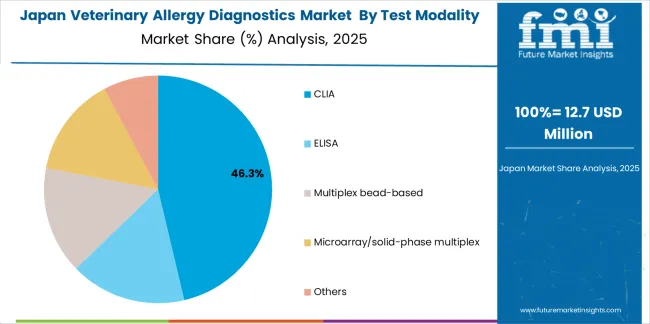
Advanced veterinary technology market in Japan demonstrates sophisticated allergy diagnostic integration with documented clinical effectiveness in premium companion animal applications and modern facility installations through integration with existing technology systems and veterinary infrastructure. The country maintains a 3.8% growth rate, leveraging traditional technology expertise and precision systems integration in diagnostic technology. Veterinary centers, including Tokyo, Osaka, and Nagoya, showcase premium installations where diagnostic systems integrate with traditional technology platforms and modern facility management systems to optimize companion animal operations and maintain technology quality profiles.
Japanese veterinary providers prioritize diagnostic precision and technology consistency in allergy testing development, creating demand for premium systems with advanced features, including technology monitoring and automated diagnostic systems. The market benefits from established technology infrastructure and commitment to veterinary standards that provide long-term operational benefits and compliance with traditional quality companion animal methods.
Advanced veterinary technology market in UK demonstrates sophisticated allergy diagnostic integration with documented clinical effectiveness in comprehensive companion animal applications and modern facility installations through integration with existing veterinary systems and pet care infrastructure. The country maintains a 3.6% growth rate, leveraging traditional veterinary expertise and comprehensive systems integration in diagnostic technology. Veterinary centers, including London, Manchester, and Birmingham, showcase comprehensive installations where diagnostic systems integrate with traditional veterinary platforms and modern facility management systems to optimize companion animal operations and maintain veterinary service profiles.
British veterinary providers prioritize diagnostic comprehensiveness and clinical consistency in allergy testing development, creating demand for comprehensive systems with advanced features, including clinical monitoring and automated diagnostic systems. The market benefits from established veterinary infrastructure and commitment to companion animal standards that provide long-term operational benefits and compliance with traditional quality veterinary methods.
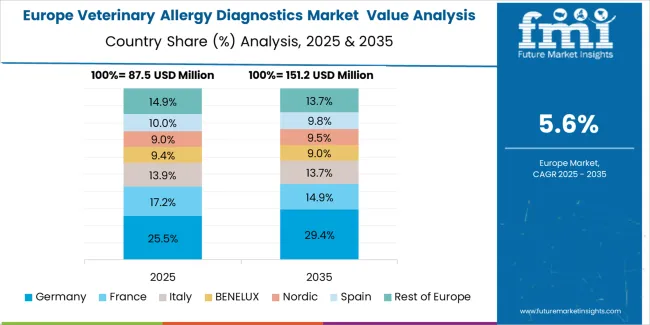
The European veterinary allergy diagnostics market is projected to represent a significant portion of global consumption, with strong regional distribution across major economies. Germany is expected to maintain its leadership position with USD 26.9 million in 2025, accounting for 27.6% European market share, supported by its advanced veterinary infrastructure and major companion animal centers.
Spain follows with USD 14.7 million, representing 15.1% European market share in 2025, driven by comprehensive pet care programs and diagnostic technology development initiatives. United Kingdom holds USD 18.7 million through specialized veterinary applications and diagnostic compliance requirements. France commands USD 10.2 million, while Italy accounts for USD 5.8 million in 2025. BENELUX maintains USD 6.6 million, Nordic Countries hold USD 9.7 million, and the rest of Western Europe region accounts for USD 4.8 million, attributed to increasing diagnostic system adoption in emerging veterinary facilities implementing companion animal modernization programs.
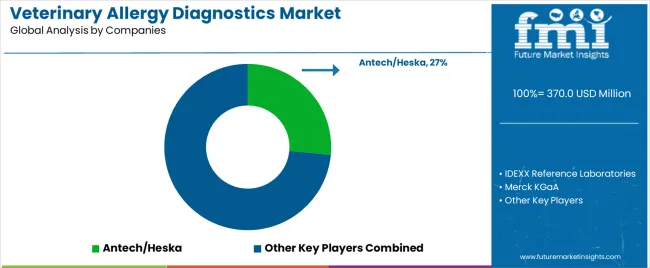
| Stakeholder | What they actually control | Typical strengths | Typical blind spots |
|---|---|---|---|
| Global platforms | Distribution networks, broad diagnostic portfolios, testing facilities | Proven reliability, multi-region support, comprehensive service | Technology refresh cycles; customer lock-in dependency |
| Technology innovators | R&D capabilities; advanced testing systems; digital interfaces | Latest technology first; attractive ROI on specialized applications | Service density outside core regions; customization complexity |
| Regional specialists | Local sourcing, fast delivery, nearby clinical support | "Close to clinic" support; pragmatic pricing; local regulations | Technology gaps; talent retention in diagnostic development |
| Application-focused ecosystems | Veterinary expertise, clinical support, specialized solutions | Lowest application variation; comprehensive veterinary support | Scaling costs if overpromised; technology obsolescence |
| Service specialists | Diagnostic programs, testing supply, clinical training | Win service-intensive applications; flexible support | Scalability limitations; narrow market focus |
Key Players in the Veterinary Allergy Diagnostics Market
| Items | Values |
|---|---|
| Quantitative Units (2025) | USD 370.0 million |
| Test Modality | CLIA ( chemiluminescent immunoassay), ELISA, Multiplex bead-based, Microarray/solid-phase multiplex, Others |
| Species | Canine, Feline, Equine, Others |
| End User | Veterinary Clinics & Hospitals, Emergency Hospitals, Academic Hospitals, Veterinary Dermatology & Specialty Clinics, Others |
| Regions Covered | East Asia, Western Europe, South Asia Pacific, North America, Latin America, Middle East & Africa |
| Countries Covered | China, Germany, United States, Japan, India, South Korea, Brazil, France, United Kingdom, and 25+ additional countries |
| Key Companies Profiled | Antech / Heska , IDEXX Reference Laboratories, Merck KGaA , Nextmune , Stallergenes Greer, Artuvet |
| Additional Attributes | Dollar sales by test modality and species categories, regional adoption trends across East Asia, Western Europe, and South Asia Pacific, competitive landscape with diagnostic suppliers and veterinary service providers, veterinarian preferences for testing consistency and clinical reliability, integration with veterinary platforms and clinic management systems, innovations in diagnostic technology and testing enhancement, and development of advanced veterinary allergy diagnostic solutions with enhanced performance and clinical optimization capabilities. |
The global veterinary allergy diagnostics market is estimated to be valued at USD 370.0 million in 2025.
The market size for the veterinary allergy diagnostics market is projected to reach USD 714.4 million by 2035.
The veterinary allergy diagnostics market is expected to grow at a 6.8% CAGR between 2025 and 2035.
The key product types in veterinary allergy diagnostics market are clia, elisa, multiplex bead-based, microarray/solid-phase multiplex and others.
In terms of species, canine segment to command 72.3% share in the veterinary allergy diagnostics market in 2025.






Full Research Suite comprises of:
Market outlook & trends analysis
Interviews & case studies
Strategic recommendations
Vendor profiles & capabilities analysis
5-year forecasts
8 regions and 60+ country-level data splits
Market segment data splits
12 months of continuous data updates
DELIVERED AS:
PDF EXCEL ONLINE
Veterinary TSE Testing Market Size and Share Forecast Outlook 2025 to 2035
Veterinary Dermatology Market Forecast Outlook 2025 to 2035
Veterinary Telemedicine Market Size and Share Forecast Outlook 2025 to 2035
Veterinary Dietary Supplements Market Size and Share Forecast Outlook 2025 to 2035
Veterinary Imaging Market Forecast and Outlook 2025 to 2035
Veterinary CRISPR-Based Detection Kits Market Size and Share Forecast Outlook 2025 to 2035
Veterinary Pregnancy Test Kit Market Forecast and Outlook 2025 to 2035
Veterinary X-Ray Illuminators Market Size and Share Forecast Outlook 2025 to 2035
Veterinary Scales Market Size and Share Forecast Outlook 2025 to 2035
Veterinary Grooming Aids Market Size and Share Forecast Outlook 2025 to 2035
Veterinary Micro-fibre Endoscope Market Size and Share Forecast Outlook 2025 to 2035
Veterinary Faecal Filters Market Size and Share Forecast Outlook 2025 to 2035
Veterinary Dental Equipment Market Size and Share Forecast Outlook 2025 to 2035
Veterinary Rapid Test Market Size and Share Forecast Outlook 2025 to 2035
Veterinary Therapeutic Diet Market Size and Share Forecast Outlook 2025 to 2035
Veterinary Glucometers Market Size and Share Forecast Outlook 2025 to 2035
Veterinary Pain Management Drugs Market Size and Share Forecast Outlook 2025 to 2035
Veterinary Anesthesia Machines Market Size and Share Forecast Outlook 2025 to 2035
Veterinary Thermography Market Size and Share Forecast Outlook 2025 to 2035
Veterinary Respiratory Disease Treatment Market Size and Share Forecast Outlook 2025 to 2035

Thank you!
You will receive an email from our Business Development Manager. Please be sure to check your SPAM/JUNK folder too.
Chat With
MaRIA